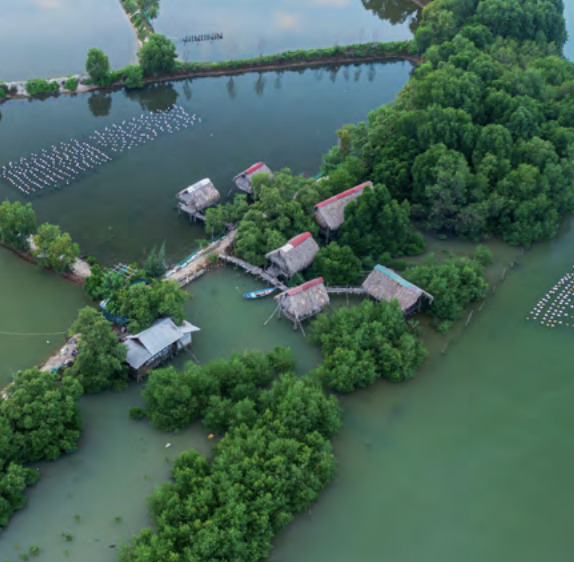Transboundary Climate Risks and the National Adaptation Planning Process

Introduction
As the impacts of climate change are felt by more and more communities around the world, governments are increasingly using their National Adaptation Plan (NAP) processes to identify and address their medium- to long-term priorities for adaptation to climate change and integrate them into development planning and budgeting processes. Although adaptation is place-based, climate change is not contained within political borders. The impacts of climate change can generate both risks and opportunities at the transboundary level, irrespective of the sovereign boundaries that appear on the map. Similarly, adaptation responses can also have transboundary effects, both positive and negative, and, as such, transboundary coordination and collaboration on adaptation planning should be encouraged to help address and manage these risks.
This brief aims to offer adaptation practitioners, policy-makers, and negotiators—especially those involved in their countries’ NAP processes—new perspectives on how the NAP process can play a role in addressing transboundary climate risks. Through a systematic review of NAP documents, this brief provides new insights into how transboundary climate risks are currently being featured in countries’ NAP documents and reveals future opportunities for stronger integration of such risks into NAP processes.
This article is an abridged version of the original text, which can be downloaded from the right-hand column. Please access the original text for more detail, research purposes, full references, or to quote text.
Method
A systematic review of NAP documents aimed to investigate how transboundary climate risks are approached and discussed in the 41 NAP documents (multisector NAPs only) that had been submitted to the United Nations Framework Convention on Climate Change (UNFCCC) by January 2023. It further assessed which transboundary climate risks countries referred to, building on the four main pathways through which climate impacts can transmit and generate cascading risks across borders and scales.
A content analysis was performed using a subset of questions and a systematic search of keywords associated with the concept of transboundary climate risk and pathways. The review also examined if countries identified adaptation solutions of a transboundary nature and what opportunities may exist to expand these discussions moving forward.
Observations from the NAP document review
The following section presents the key findings from the NAP document review:
- While countries make sporadic references to what can be considered transboundary issues, they do not systematically apply a conceptual logic and deliberative approach to identifying and assessing transboundary climate risks.
- Several NAP documents identify and describe climate-driven changes and risks related to shared ecosystems and natural resources, in particular transboundary waterways, river basins, and lakes.
- The transboundary climate risks associated with ocean acidification, warming, and biodiversity decline, specifically the decline in fish stocks and coral reef degradation, are a common theme across coastal countries, including Small Island Developing States.
- Several African NAPs note the challenges of and threats posed to cross-border pastoralism in a changing climate.
- A quarter of the NAP documents scanned mention potential transboundary transmissible disease risks associated with a changing climate.
- A small number of NAP documents refer to supply chains and commodity prices but primarily from the perspective of a country’s own ability to export key commodities due to the impacts of climate change.
- Most conflict-affected countries that have submitted NAPs identify climate change as a “threat multiplier” and a potential driver of future transboundary resource conflicts.
- Countries identified adaptation options, channels, and actors to address climate change collaboratively within their region.
To explore the observations in more detail, please refer to pages 3-6 of the briefing note.
The role of NAPs in addressing transboundary climate risks
It must be recognized that NAP processes are already complex undertakings that involve several research and administrative burdens for countries. Adding the assessment and governance of transboundary climate risks to the agenda may be overwhelming. On the other hand, the increasing recognition of transboundary climate risks and potential amplification of their international dimensions arguably requires NAP processes to pay closer attention to their implications and identify suitable responses. Several countries are currently assessing their NAP progress and are updating their plans, providing opportunities for them to consider interregional effects and/or cross-reference the NAPs of neighbouring countries to integrate transboundary climate risks in future iterations.
The review of current NAP documents offers some considerations for how their role may be enhanced to address transboundary climate risks:
- Harness the role of non-state actors and intergovernmental organizations who focus on the collaborative management of shared ecosystems and resources or regional cooperation throughout the NAP process.
- Provide support to NAP teams for integrating transboundary considerations in assessing climate vulnerabilities and identifying and implementing adaptation options.
- Use transboundary climate risks identified in NAP documents as a basis for developing a more territorial- or ecosystem-level framing of adaptation, facilitating regional collaboration around adaptation planning.
- Additional support is required to explore more complex transboundary climate risks.
To explore the considerations in more detail, please refer to pages 6-9 of the briefing note.
Further resources
- Suggested Citation:Terton, A., Qi, J. and Tadgell, A. (2023). Transboundary Climate Risks and the National Adaptation Planning Process. International Institute for Sustainable Development. Available at: https://napglobalnetwork.org/resource/transboundary-climate-risks-and-nap-process/
Related resources
- Policy brief: How can Africa manage the transboundary climate risks it faces?
- Enhancing cooperation to address cascading climate risks in the Hindu Kush Himalaya
- Climate risks to trade and food security: implications for policy
- Addressing Loss and Damage: What can we learn from countries’ National Adaptation Plans?
- Guidelines for Integrating Ecosystem-based Adaptation (EbA) into National Adaptation Plans (NAPs)

(0) Comments
There is no content